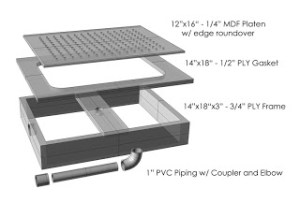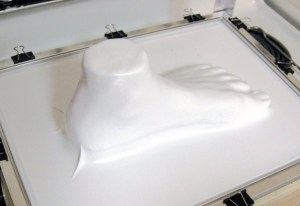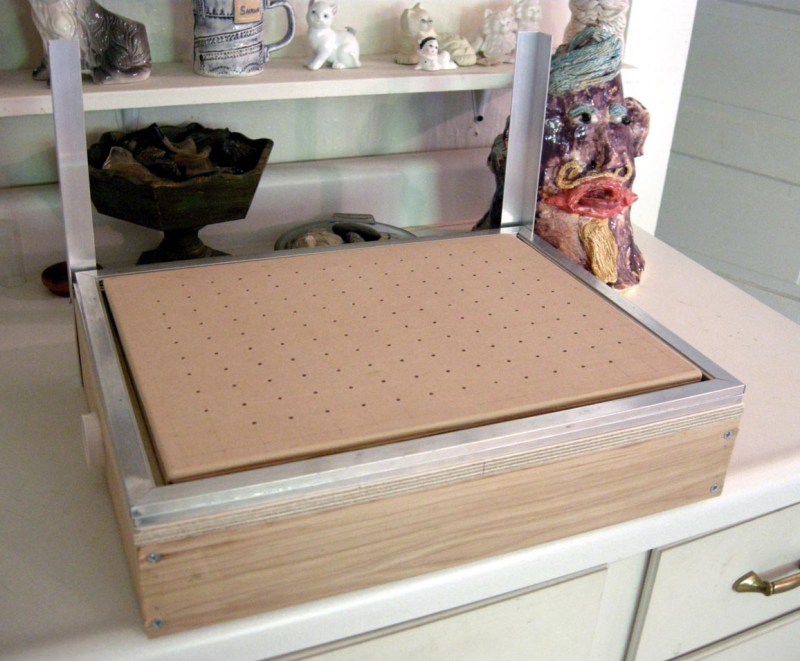Vacuum Forming is a process used to mold plastic into a desired shape. A thin sheet of plastic is heated to a soft state and then air pressure is used to press the plastic down around or into a mold. Vacuum forming can be used to make a variety of items, anything from product packaging to bath tubs.
That being said, a vacuum former is probably one of those things that would be nice to have around but may not get a lot of use. Therefore, spending any significant amount of money on one would result in a low-value situation. For some folks, building one from scratch may be the way to go. [Amalgamized] built his own low-cost vacuum former and did a great job documenting the build.
 There is a two-pronged attack to keep the costs down on this project. First, the frame is made from readily available materials that you probably have kicking around in your wood scrap bin. The sides of the frame are 3/4″ plywood and the hole-filled top is made from 1/4″ MDF. A piece of PVC pipe connects the chamber below the top piece of MDF to a shopvac. The shopvac pulls the air down through the top’s holes; think reverse air hockey table.
There is a two-pronged attack to keep the costs down on this project. First, the frame is made from readily available materials that you probably have kicking around in your wood scrap bin. The sides of the frame are 3/4″ plywood and the hole-filled top is made from 1/4″ MDF. A piece of PVC pipe connects the chamber below the top piece of MDF to a shopvac. The shopvac pulls the air down through the top’s holes; think reverse air hockey table.
Attack prong #2 is that there is no dedicated heater. Binder clips secure the plastic sheets to an aluminum window frame which are then put in the oven for a few minutes between 250 and 300ºF. When the plastic starts to droop, it is quickly removed from the oven and placed over a mold. The shopvac creates a low pressure zone under the plastic and atmospheric pressure pushes the plastic down around the mold.
















What’s the big deal – people have been using these for years, making them for next to free, and there are many tutorials around for making such vacuum forming tables. Surprised this got onto Hack-A-Day. What’s next, how to boil an egg??
I’ve not seen these before (but have used a real vacuum former) so found this info useful to have if I ever need one!
I didn’t think a shopvac could create the required suction.
This is also a ‘real’ vacuum former. You used something similar to this.
I made on similar, cheaper though.
4 thin planks with 2 x 4mm boards for the top and bottom. Bathroom sealant makes it air tight and a hole in the side pork re a great place to just put a hose from and old Hoover.
Total cost is basically nothing (assuming you have the scrap,) the biggest thing is drilling a grid of holes – it’s repetitive blaring stuff that makes your arm ache.
What’s the big deal about portable psones? You have one you made on your site, there are heaps out there, why bother posting it on the net? I’m sure you have many reasons, many of which would be applicable here.
And also, now that I have seen this on My Favourite News Site™, realised that such a thing exists, I can search for more versions on the net.
Like my old teachers used to say, if you don’t have something constructive to say, don’t say it all. So. Stfu and get off my lawn.
Sorry everyone else for feeding the troll.
Yeah, I want to learn how to boil and egg.
I think this stuff is interesting. If you get bored with it, go to another site, like…..well, there ain’t one like Hackaday.
I’m worried about heating the plastic in the oven, get distracted for a minute and your food will taste funny for years!
It’s highly recommended to use an old oven you don’t cook food in anymore.
yea sure, I’ll go get my spare oven.
Check craigslist or the curb the night before trashday. Ovens get thrown out all the time.
That said most people use a toaster oven or buy NiChrome/other resistive wire and make their own heating element.
How about using a hi-powered blow dryer? High heat and slow air flow will melt the plastic in no time.
its ok, you can use the same one you use for your carbon fiber
I wonder if those halogen room heaters would do, if you held the plastic up to one of those long enough, could be dual purposed as a room heater.
Yes it will, here’s mine that was featured on HaD a while ago:
http://xrobots.co.uk/vacuum/
You could use a heat gun too, I’d think….
Like the use here, but perhaps for vacuum holding of materials for CNC??
RoboMonkey, yes it is quite common to use Vacuum tables for that purpose as well.
clean build and all. not trying to troll but seriously putting plastic like that in your oven is a bad idea. Also if this is portable how often can you be at someones house and say “hey let me throw this sheet of plastic in your oven” wont normally go over well. it really would not be that difficult to make a nichrome wire element that you can put over the plactic to heat it and then you would not have to worry about it at all.
I made mine portable so that I could use it in the house where the oven is and store it in the garage where the rest of the tools live.
Didn’t need to ask permission as it was my house…
Does anyone one have a good online source for vacuum forming sheets?
milk jugs
If you reinforced it, could peg board be used for the grid of holes? The holes would probably be larger than if you drilled them yourself… not sure at what point that becomes a weak point. The peg board would need to be reinforced with something, though.
it depends on the thickness of the plastic, at 0.6mm acrylic sheet you notice small 1mm holes appearing in the surface on on parts where you have indentations…
to explain better, imagine a pencil tray, large side walls, and pockets, you need to drill through those pockets in the mould, and a thin sheet will start to get pulled through the holes you’re using to vent cavities…
4mm holes will just pull thin sheets right through as bubbles that pop and reduce the vacuum.
There was no trolling. It takes an hour and some scrap wood, duct tape, several screws and piece of plumbing (for the vacuum machine to link into). You can make one for a couple of bucks. There are many many YouTube tutorials on making a vacuum forming table, and sites around too. Regarding suction, one decent vacuum machine can work as long as you only have minimum number of holes in the top, also I tried a while back with 12mm thick MDF and the suction caved in the table, so surprised 4mm thick MDF or similar works – I use 20mm MDF. Vacuum suction is quite strong after all as it needs to be. Also with the styrene, no issue using you oven as it doesn’t give off fumes too much (doesn’t smoke), and 1.5mm thick is perfectly fine, 2mm thick max.
HaD is about innovation, creativity and invention. The vacuum former is none of those; it is a tool to make something rather than being it.
BTW one tip, especially if you are trying to make two halves of a case to meet together, when you’ve done vacuum forming, release it from the mold, trim away the excess styrene from the sides, then put it back in the mould as best you can and use a heat gun (I use a 2Kw one) to soften the plastic and then press that onto the mould; you will then have your case halves meeting more accurately.
Why did you post this on HaD? HaD is about innovation, creativity and invention, and your comment is none of those. Your “one tip” is a tip to on how to make something rather than being it.
I made a small vacuum table using two scrap MDF cabinet doors. The center panels are 1/4″ thick. The doors are screwed together, leaving a 1/2″ space in the middle. I drilled 1/8″ holes 3/4″ on center in the door to use as the platen, and I just used common plumbing fittings on the underside to attach my shop vac to.
I would post a couple of photos if I knew how.